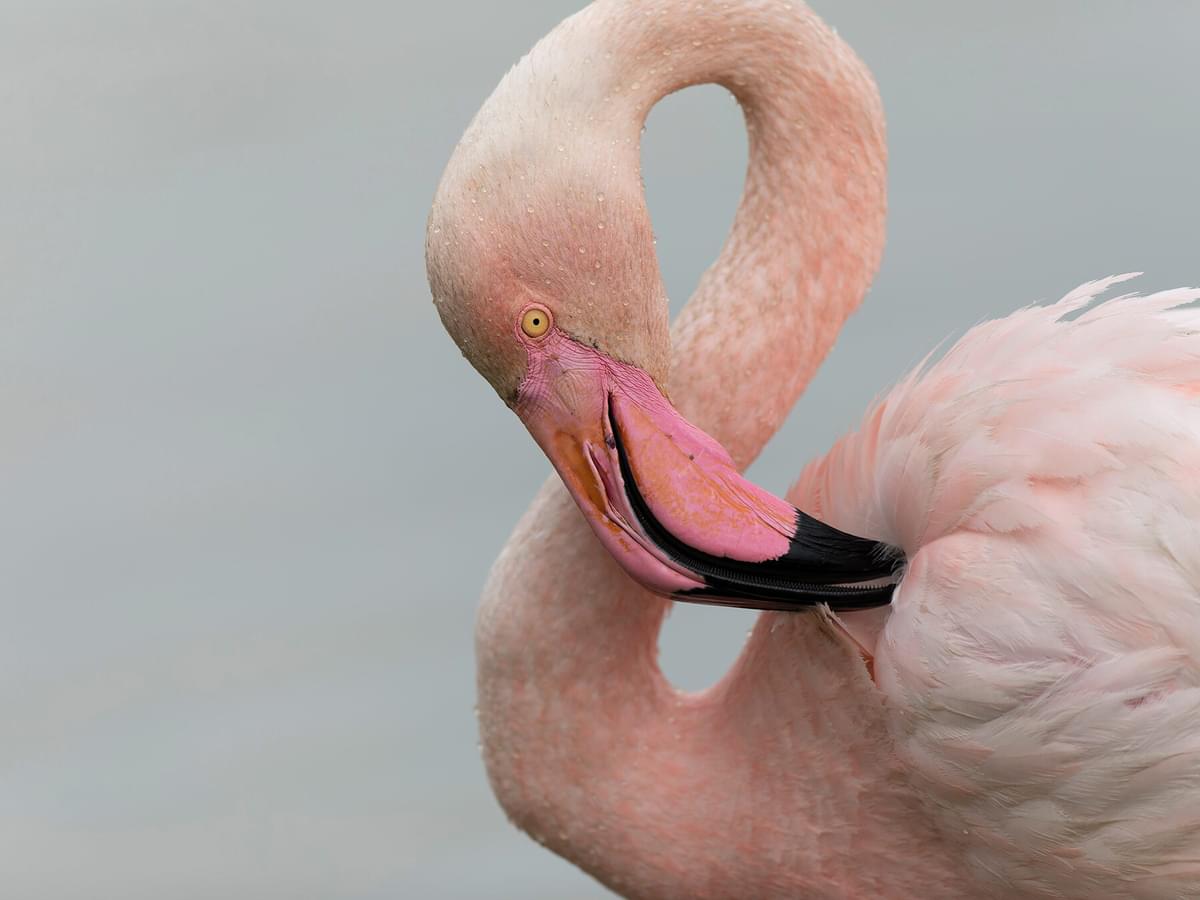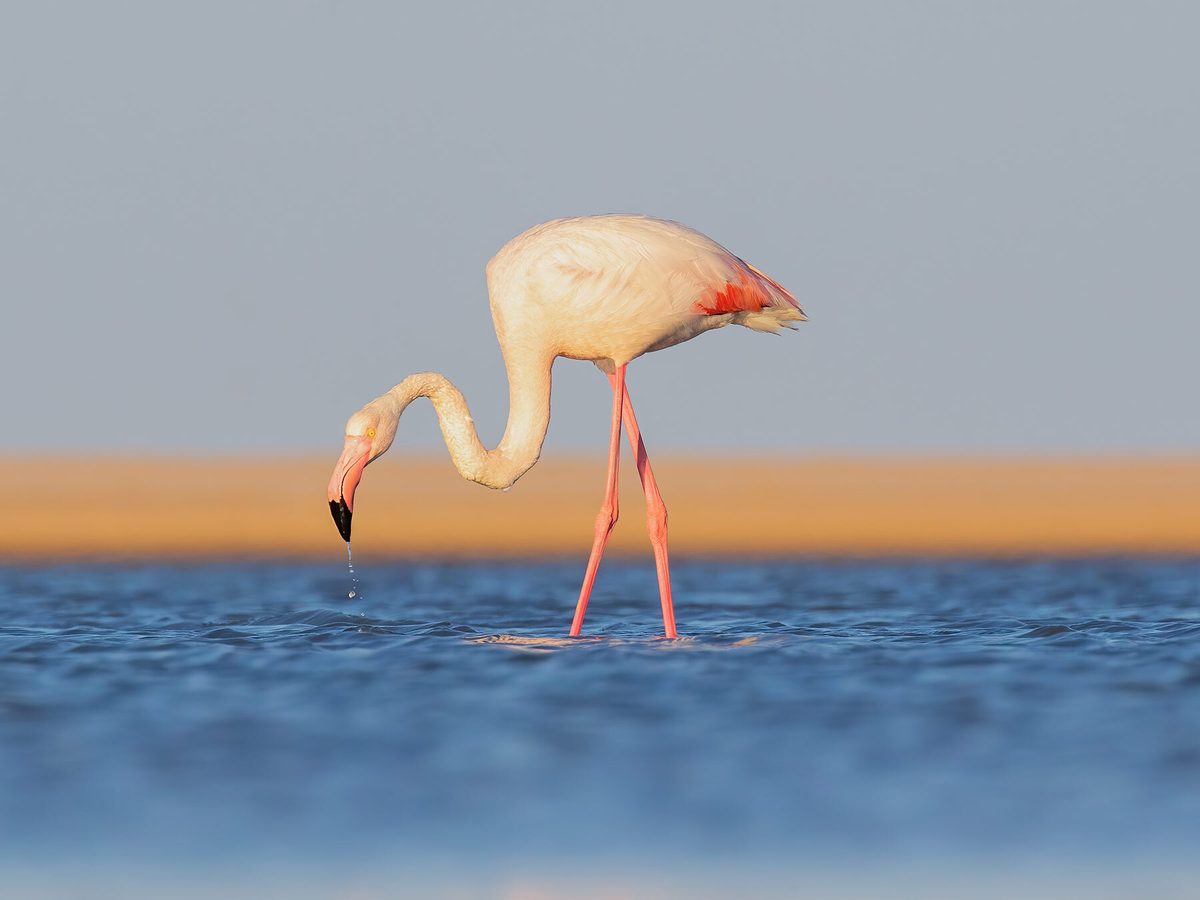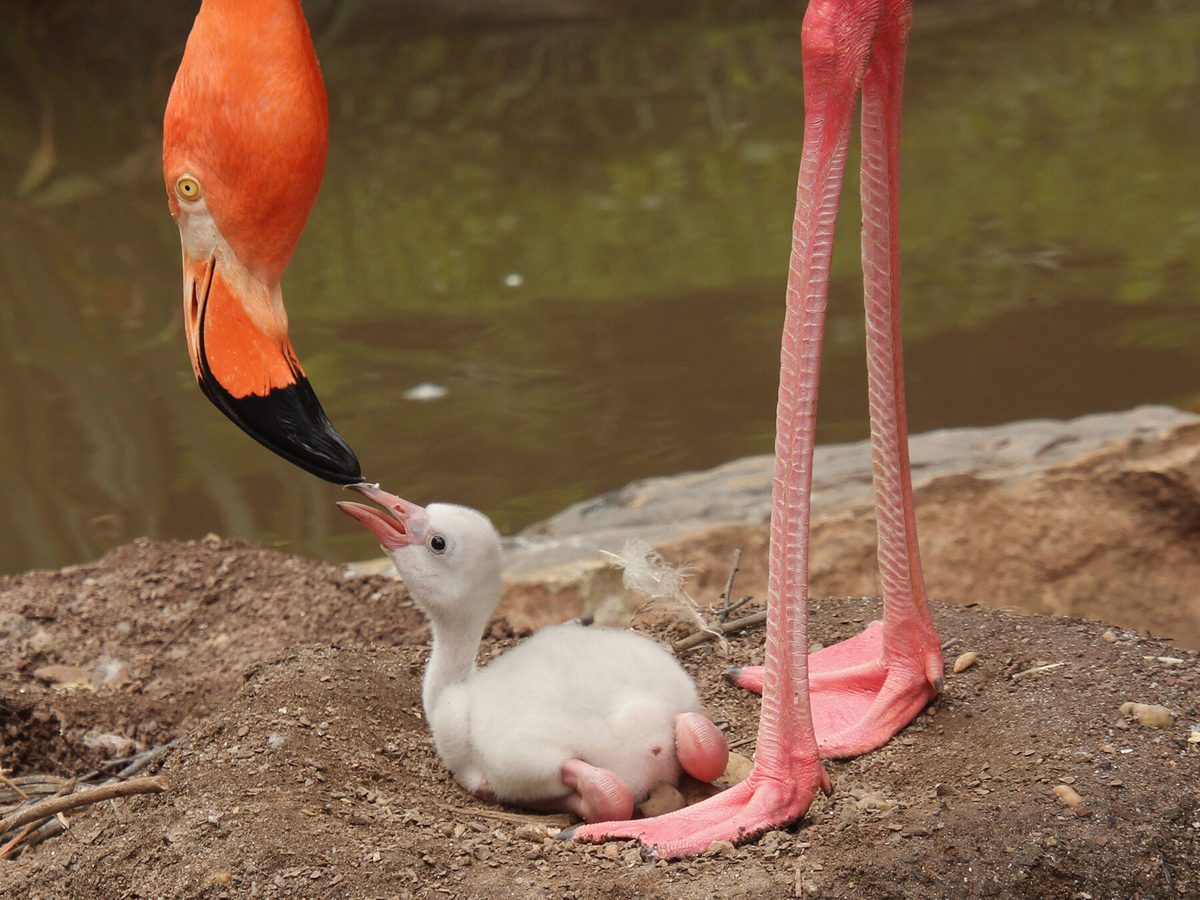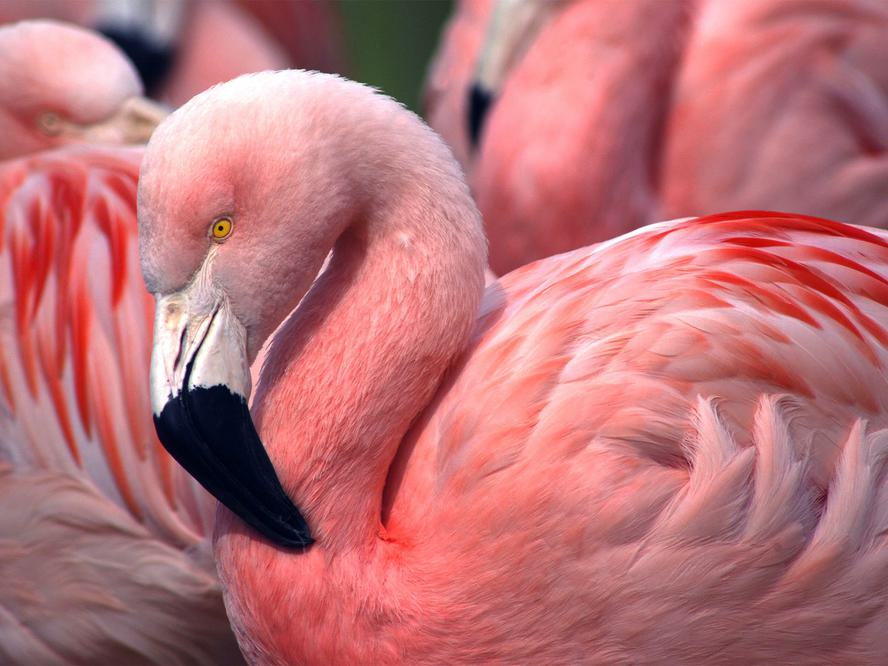Jump to Section
What Do Flamingos Eat? (Complete Guide)
Last updated: 30 November 2021

Flamingos are for sure one of the most bizarre-looking birds around, famed for their pink dyed plumage, long legs and unusual collective mating displays. Flamingos are actually the only bird left in their order Phoenicopteriformes - the rest are extinct. These tall wading birds have an interesting diet to match their other funky characteristics, so what do flamingos eat?
Flamingos are not born pink but instead turn pink throughout their lives due to their algae-rich diet. Their diet consists mainly of algae and shrimp, and other shellfish that also consume algae. Algae is full of carotenoids - naturally occurring nutrients and pigments that are also found in colourful vegetables like carrots, peppers and tomatoes. Once metabolised, these carotenoids dye flamingos pink.
Whilst all species of flamingos have similar diets, the quantities and type of algae they consume have a bearing on how pink they are. Interestingly, their pink hues have come to affect them in other ways, too, as healthy mates are often selected based on how dark pink their plumage is, thus indicating that they have a particularly rich diet.
Read on to discover more about the feeding habits of this quirky bird!

Flamingo eating and searching for food in the water
What do flamingos eat in the wild?
All species of flamingos eat blue-green and red algae as well as small crustaceans like shrimp, prawns, crabs and crayfish and molluscs, small fishes and also some seeds and plant matter.
Algae is the mainstay of some flamingo species' diets, including the Lesser, James' and Andean flamingos, whereas fish, crustaceans and larger organisms are preferred by the Greater, Caribbean and Chilean flamingos. It depends on what organisms are present in their lake and lagoon habitats, which also varies with the pH of the water. Very acidic or very alkali waters are less likely to harbour complex marine life.
The carotenoids that make flamingos go pink or red is metabolised not just from algae itself but also second-hand from shrimps and other foods that feed upon the algae. The pinkest flamingos still tend to be those that eat the most algae and the least meat.

A pair of Andean Flamingos feeding together
How do flamingos feed?
Prior to feeding, flamingos often stomp their feet on the lake or lagoon bed to stir up mud and sediment, releasing algae and other foods in the process.
Flamingos are known as filter feeders and feed with their heads upside down, facing backwards towards their bodies. Their bill is adapted for this too and has quite a pronounced downwards curve. Their lower bill is actually much stronger than their upper bill and can move independently, enabling the flamingo to rapidly pump water through its internal filtering system.
This upside-down stance allows flamingos to accurately scoop water in their high capacity upper bills and pump the water through hair-like lamellae which effectively strain even very small creatures like algae and diatoms. It’s a complex and highly adapted filtering system that can also be observed in some waterfowl such as Mallards.
Lesser, James' and Andean flamingos are more specialised in straining algae whereas Greater, Caribbean and Chilean flamingos are more adept at straining larger organisms such as crustaceans, larvae, molluscs and small fish.

Close up of flamingo feeding in the water
What do flamingos eat to turn pink?
Flamingos are world-renowned for their pink or red plumage, but baby flamingos are actually a dull grey and not pink at all. The word flamingo itself comes from the Spanish ‘flamengo’ for ‘flame-coloured’.
The rather specialised diet of the flamingo consists of vast quantities of blue-green and red algae and other creatures that feed upon algae. This does vary between species to species - some flamingos (e.g. the American flamingo) are much pinker than others (e.g. the Lesser flamingo). These algae contain high concentrations of nutrients and natural dyes called carotenoids, particularly beta-carotene, which is present in carrots and sweet potatoes.
Liver enzymes break down the carotenoids, and the pigments are reabsorbed and later deposited in the flamingo’s feathers and skin. Juvenile flamingos will gradually get darker over the course of 2 to 5 years.

A pair of juvenile Flamingos, with a dull grey plumage
Why are some flamingos pinker than others?
Not all flamingos are the same colour or shade of pink. American flamingos are some of the brightest pink or red due to their particularly algae-rich diet, while Lesser flamingos tend to be lighter pink, especially in areas of lesser algae abundance. Colour also varies with the proportions of the flamingo’s diet, as those who eat almost solely algae, and thus get their carotene first-hand, are darker than those who eat shrimp and molluscs and therefore get their carotene second-hand.
Greater flamingos have also been observed to directly preen their feathers with beta-carotene-rich secretions produced in a gland near their tail. This allows them to ‘top up’ their colourful plumage to help them attract a mate.
What do baby flamingos eat?
Baby flamingos are fed solely on crop milk for some two months. The crop is an extension of the digestive tract, which allows birds to store food and partially digest it before either passing it to the stomach or regurgitating to feed chicks.
Adult birds will partially digest food in their crop before regurgitating it into the chick’s mouth to feed it. Flamingo milk is often bright red, leading some to liken it to blood. Other birds that feed their young crop milk include pigeons, doves and penguins.
After around two months, the baby flamingo will begin to consume food from its environment in much the same way as an adult, by placing its head underwater and filtering for food such as algae and small crustaceans.

An adult Flamingo feeding their baby crop milk
What do flamingos eat in the winter?
Depending on where they live, some colonies of flamingos do actually migrate in winter. For example, many Greater flamingos living in central Asia migrate to India during the winter, and James’ flamingos migrate to a lower altitude when their lake feeding grounds freeze over.
Once flamingos locate a suitable feeding ground to colonise over winter, their diets will remain similar to that of summer, including plenty of algae and small crustaceans and molluscs.
Are flamingos omnivores?
Flamingos are classified as omnivorous birds, and they will filter and eat whatever nutritious organisms they can find in their lake or lagoon habitats. This includes both algae and meat of various kinds, primarily molluscs, crustaceans and other shellfish, insects, larvae and small fish.
Whilst some species of flamingos are more adept at filtering more significant non-algae foods, all flamingos are omnivores.

Close up of a Chilean Flamingo
Do flamingos eat shrimp?
Flamingos do eat shrimp, and those shrimp they eat are also likely pink in hue for the same reason flamingos are - because they consume algae from their environment.
All flamingos are omnivores, despite some having a majority algae diet and others leaning more towards meat.
Do flamingos eat krill?
Krill are shrimp-like crustaceans that live in the oceans and seas, mainly in colder waters at depths of below 50m or so, though this does vary. As such, flamingos do not eat krill as they’re not seabirds and prefer to live in still lakes and lagoons.
There may be some rare scenarios where krill make their way to coastal lakes and lagoons and possibly then into the diets of flamingos.

A group of Flamingos in Laguna Colorada in Bolivia
Do flamingos eat vegetables?
Flamingos are omnivores and will eat plant matter if present in their environment. Whilst they’re not specialised for ripping and tearing plant matter from the lakebed, they will still consume any filtered plant matter or seeds.
Do flamingos eat crabs?
Greater, Caribbean and Chilean flamingos consume crabs and other shellfish in higher quantities than other species of flamingos. Their diet includes crabs, lobsters, shrimps, crayfish, barnacles and prawns, though they’d likely only consume the very smallest harder-shelled crustaceans.
Do flamingos eat fish?
If fish are present in their environment, then flamingos will eat them as part of their standard diet. The Greater flamingo has perhaps the most extraordinary appetite for fish and is excellent at sifting through more significant quantities of water to sustain its diet.

Greater Flamingo fishing in the lake
Do flamingos eat meat?
All species of flamingos are omnivorous to an extent, so yes, all flamingos do eat meat. Algae is preferred by some species of flamingos, whereas meat is preferred by others. It really depends on what types of organisms are living in the typical flamingo lake or lagoon habitat - there could be a myriad of fish and other sea creatures or very few.
Do flamingos eat upside down?
Yes, and the entire jaw structure of the flamingo has adapted to enable this.
When flamingos eat, they dunk their head in the water upside down, pointing towards their bodies. They then suck water in through comb-like structures, using their tongue to pump water through their filtration system at a rate of some four times a second.
Flamingos are one of the only animals that can move their bottom jaw independently of the top - their bottom bill is also considerably stronger than their top.

Flamingos eating upside down
Do flamingos eat frogs?
It’s feasible to think that somewhere, at some point, a frog has made its way into a lake or lagoon only to find itself scooped up by a flamingo. But this would be a very rare encounter, and whilst flamingos are omnivores, they consume pretty much only crustaceans and molluscs as far as meat goes.
On this page
- What do flamingos eat in the wild?
- How do flamingos feed?
- What do flamingos eat to turn pink?
- Why are some flamingos pinker than others?
- What do baby flamingos eat?
- What do flamingos eat in the winter?
- Are flamingos omnivores?
- Do flamingos eat shrimp?
- Do flamingos eat krill?
- Do flamingos eat vegetables?
- Do flamingos eat crabs?
- Do flamingos eat fish?
- Do flamingos eat meat?
- Do flamingos eat upside down?
- Do flamingos eat frogs?





